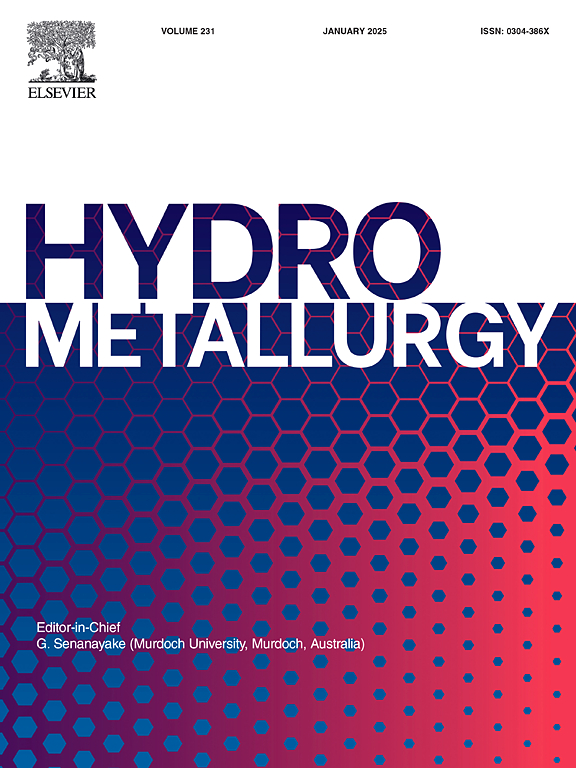利用CO2作为沉淀剂从NaAl(OH)4溶液中制备氢氧化铝:反应动力学及机理研究
IF 4.8
2区 材料科学
Q1 METALLURGY & METALLURGICAL ENGINEERING
引用次数: 0
摘要
铝酸钠溶液碳酸化反应是制备氢氧化铝和氧化铝最重要、最环保、最经济的工艺。控制NaAlO2溶液的碳化反应速率和反应终点羟基离子浓度(pH)是最关键的技术要求。然而,碳酸化反应机理仍存在争议,对氢氧离子的反应动力学尚无相关研究,影响了碳酸化反应的控制和反应器的设计。本文报道了对pH和氢氧离子浓度变化的原位研究,通过与NaOH溶液的碳酸化反应对比,提出了NaAlO2的两阶段碳酸化反应机理。反应机理的第一阶段是NaAlO2溶液中CO2与未结合NaOH之间的中和反应。第二阶段的反应机理是一系列的三个化学反应:(i) NaAlO2分解生成NaOH, (ii)生成的NaOH与CO2中和,(iii)碳酸盐离子水解。其次,创新性地提出了一种新的NaAlO2溶液自发分解反应实验方法,揭示了两个一级分解反应。反应速率常数约为3 × 10−3 s−1。在此基础上,推导了由传质速率和化学反应速率控制的两段碳酸化反应的氢氧离子速率方程。拟合的实验数据相关系数均大于0.99。研究发现,碳酸化反应的分解速率常数大于NaAlO2溶液的自发分解速率常数。氢氧根离子浓度的下降速率影响碳酸化反应的分解速率。最后,实验测量的CO2消耗量与动力学计算的CO2消耗量完全一致,验证了反应机理和所提速率方程的正确性。本文章由计算机程序翻译,如有差异,请以英文原文为准。

Utilization of CO2 as a precipitant to prepare aluminum hydroxide from NaAl(OH)4 solutions: Study on reaction kinetics and mechanism
The carbonation reaction of sodium aluminate solution is the most important, green and economical process for preparing aluminum hydroxide and alumina. Controlling carbonation reaction rate and hydroxyl ion concentration (pH) at the reaction endpoint of NaAlO2 solution is the most critical technical requirement. However, carbonation reaction mechanism is still controversial, and there is no relevant study on the reaction kinetics of hydroxide ion, which affects the control of carbonation reaction and reactor design. This paper reports the study of the change of pH and hydroxide ion concentration in situ, to propose a two-stage carbonation reaction mechanism of NaAlO2 by comparing with carbonation reaction of NaOH solution. The first stage of reaction mechanism is the neutralization reaction between CO2 and uncombined NaOH of NaAlO2 solution. The second stage of reaction mechanism is a sequence of three chemical reactions: (i) NaAlO2 decomposition generating NaOH, (ii) neutralization between generated NaOH and CO2, and (iii) hydrolysis of carbonate ions. Secondly, a new experimental method of spontaneous-decomposition reaction of NaAlO2 solution was innovatively proposed, revealing two first-order decomposition reactions. The reaction rate constant was about 3 × 10−3 s−1. Furthermore, the rate equation for hydroxyl ion describing a two-stage carbonation reaction, controlled by mass transfer rate and chemical reaction rate was derived. The correlation coefficients of fitted experimental data were all greater than 0.99. Research found that the decomposition rate constant of carbonation reaction is greater than the spontaneous-decomposition rate constant of NaAlO2 solution. The decomposition rate of carbonation reaction was affected by the decreasing rate of hydroxide ion concentration. Finally, CO2 consumption measured by experiment and calculated by kinetics was completely consistent, which verifies the correctness of reaction mechanism and proposed rate equations.
求助全文
通过发布文献求助,成功后即可免费获取论文全文。
去求助
来源期刊

Hydrometallurgy
工程技术-冶金工程
CiteScore
9.50
自引率
6.40%
发文量
144
审稿时长
3.4 months
期刊介绍:
Hydrometallurgy aims to compile studies on novel processes, process design, chemistry, modelling, control, economics and interfaces between unit operations, and to provide a forum for discussions on case histories and operational difficulties.
Topics covered include: leaching of metal values by chemical reagents or bacterial action at ambient or elevated pressures and temperatures; separation of solids from leach liquors; removal of impurities and recovery of metal values by precipitation, ion exchange, solvent extraction, gaseous reduction, cementation, electro-winning and electro-refining; pre-treatment of ores by roasting or chemical treatments such as halogenation or reduction; recycling of reagents and treatment of effluents.
 求助内容:
求助内容: 应助结果提醒方式:
应助结果提醒方式:


